In operation since 2006, Mid-Valley Chimney Repair & Sweeps is the Cincinnati/Dayton area expert on all things fireplace, chimney, home heating, and ventilation. Whether you’re looking for your next heating appliance or require a bit of assistance for your current system, there is no one better for the job than Mid-Valley. If you’re looking for a stove, fireplace, or fireplace insert near Dayton, Cincinnati or somewhere else nearby, we’re the team to hire.
All of our technicians are highly trained and certified with the most revered organizations in the industry and strive to provide you with the best service possible. Are you ready to find the home heating appliance of your dreams? Get started today by calling 513-727-0994 or, if you’d prefer, you can reach us online, right here through our website.
Considering we offer a wide range of various products from some of the best manufacturers in the industry, perhaps a better question might be… What home heating appliances don’t we install?
Interested in the sleek, modern look of a freestanding stove? We’ve got ‘em. Maybe you’ve been thinking about a gas insert and the benefits those bring, but you’re not quite sure about feasibility or your different options. No worries – we’d love to chat about the benefits of inserts and the various options that would work with your existing setup. Here’s a current list of the products we happily sell, install, and service:
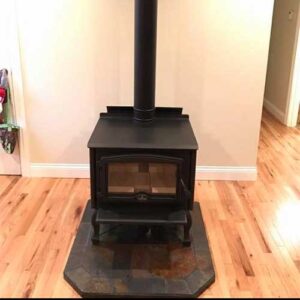
Add warmth and charm to any room with our high-quality freestanding stoves. Designed for efficiency and style, these stoves provide excellent heat output while serving as a beautiful focal point in your space. Available in both wood-burning and gas options, they’re perfect for creating a cozy atmosphere.
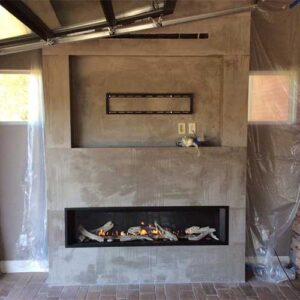
Enjoy the comfort of a roaring fire with the push of a button! Our gas fireplaces combine modern convenience with timeless elegance. They’re energy-efficient, low-maintenance, and available in a variety of designs to match your home’s aesthetic.
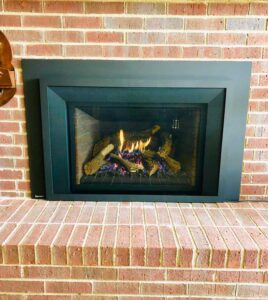
Upgrade your existing fireplace with a sleek and efficient gas insert. These inserts deliver powerful heat and realistic flames without the hassle of wood burning. They’re perfect for homeowners looking to enhance comfort and reduce energy costs.
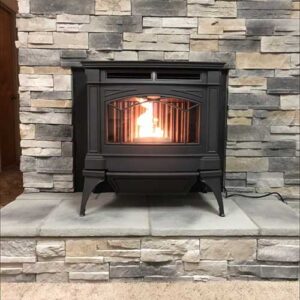
Experience the best of both worlds with our gas stoves, offering the look of a traditional stove with the ease of gas operation. These versatile heating solutions are perfect for adding warmth and ambiance to any room.
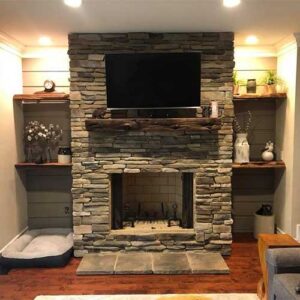
Bring the timeless tradition of a real wood fire into your home with our stunning wood-burning fireplaces. Designed for both beauty and functionality, they offer unmatched warmth and the nostalgic crackle of burning logs.
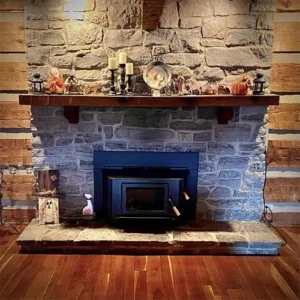
Transform your inefficient open fireplace into a high-performance heating solution with our wood-burning inserts. These inserts retain the authentic charm of wood-burning fires while providing better heat output and energy efficiency.

Stay warm all winter with our durable and efficient wood stoves. Perfect for homeowners who love the authenticity of wood heat, these stoves are built to maximize warmth while minimizing fuel use.
There are two big things to consider if you’re interested in a new heating appliance – the type of system you want and the type of fuel you want to use. Our knowledgeable Chimney Safety Institute of America (CSIA)-certified techs would be happy to help you navigate this process, so you end up with the best, most ideal addition to your home.
Depending on how much time you have and how much effort you’re willing to put into your system, which appliance is best for you may vary. We’ve provided a brief rundown of each, but if you have further questions, don’t hesitate to reach out:
Fireplace: Fireplaces are definitely the more authentic or traditional route. If you don’t have any type of heating appliance in your home, this is the route you’ll want to go. You can choose from a masonry or stone setup, which is built into your home and known for its longevity, or a prefabricated system, which can be quickly and affordably built and will last you many years.
Insert: If you already have a fireplace in your home, but are interested in changing fuel types or trying to get more efficiency out of it, then an insert is a great option. They simply fit inside of your existing fireplace, guaranteeing a seamless transition to an entirely new system.
Stove: With stoves, placement options are a lot more flexible since they are free-standing. Many are surprised at how efficiently they can heat a room, too, and models today come in a wide range of style options, so you’re sure to find the perfect fit for your space without any issues along the way.
With so many options, how can you possibly choose the one that best suits your needs and your family’s lifestyle? Is one objectively better than the other? Are there factors to consider to help you make the best decision?
In terms of objectivity, one product is not necessarily “better” than any other. It really just comes down to personal preference and the overall look you’re going for.
Looking for something with optimal heat production and efficiency? You might consider a gas insert as they tend to be more effective when it comes to the amount of warmth they provide. However, if you’re interested in installing an appliance that marries ambience and visual appeal, a classic, authentic fireplace – fueled with either gas logs or traditional wood – could be the way to go. Check out this list of general pros and cons of each different type of appliance: fireplaces, stoves, and inserts.
 What Benefits Do Fireplaces Provide?
What Benefits Do Fireplaces Provide?There is something that is inherently magical about a fireplace. Be it traditional masonry or prefabricated, gas-fueled or wood-burning, the crackling flames bring a certain cozy vibe and aesthetic to any space. However, while that may be one of the biggest draws to this type of heat, it is certainly not the only:
As with anything good, there are always some “less good” factors to balance it out. Again, it just really depends on what your goal for this new heating appliance is. Consider the following before jumping on the fireplace bandwagon:
 What Are the Benefits of Fireplace Inserts?
What Are the Benefits of Fireplace Inserts?Commonly confused with regular fireplaces, inserts are self-contained and placed directly inside of your existing fireplace and chimney system. Because the new system will utilize the chimney you already have, the transition from one to the other is unmatched. Inserts are a great option for when you want a similar look and utilization of a traditional fireplace, but are also interested in switching up the fuel source or looking for something more efficient. What else?
Easy installation. Because inserts are installed into existing setups, the installation process tends to go a whole lot smoother, simpler, and quicker. That said, don’t take this as a cue to DIY the project. Professional installation is imperative to ensure everything functions safely and appropriately for your household.
Enclosed burn. Another plus? With an insert, you don’t have to worry about sacrificing the flames for a smoke-free home fire experience. Because these systems are enclosed, you can still have a system that looks like a traditional fireplace, without needing to worry about the smoke production billowing around the room and driving everyone else out of it.
Increased efficiency. Perhaps one of the biggest reasons so many homeowners switch to an insert is because it is highly efficient. Rather than all heat escaping out the top of the chimney like with a common old-fashioned fireplace, the immense amount of heat produced by an insert is radiated back into the room – right where you can enjoy it most.
Despite the many positives of a fireplace insert, there are still some downsides to this method of heating your home:
Decreased aesthetic and ambience. While an insert removes the irritation of getting a room full of smoke and a bunch of heat lost up the chimney, it also takes away some of that classic ambiance of an open, traditional-looking fireplace.
You need a fireplace already present. Unfortunately, fireplace inserts need a system to be inserted into – hence the name. This means that, if you’re starting from scratch, installation and all that comes with it will be more complicated than simply buying a unit and having a pro set it up in your existing fireplace.
 What Are the Pros of Installing a Stove?
What Are the Pros of Installing a Stove?Stoves are an all around great alternative to both traditional fireplaces and inserts. …so long as you know what to expect. Like the two former options, there are some variations in stoves – whether in the fuel source you choose or if it is freestanding or attached to the wall – so you have to know what it is you’re looking for. Check out these unique benefits of a stove heating appliance:
Wide range of versatility. Due to the structure and design, stoves give you the opportunity to place them just about anywhere. Looking for a new heating addition to an upstairs bedroom? A freestanding stove might be a good option for you. Is your kitchen particularly drafty? A stove could do wonders in making that chilly space comfortable. Because they do not need a traditional chimney system, as long as they are able to connect to the outdoors somehow (either through roof or wall), they are typically good to go.
Provide heat and light in a power outage. Much like their wood-burning counterpart, a stove will create and provide warmth and light in the event that your power goes out. Unlike a traditional wood-fueled fireplace, though, the mess of combustion is safely contained within the appliance.
Operation is relatively low maintenance. While you still will need to obtain some type of fuel – whether it’s wood pellets, corn, cherry pits, or something else – it is nothing near what is required to maintain and operate a wood-burning fire. However, because these appliances still create flames, the general ambience is somewhat similar to a more traditional fireplace option – just with a general increase in efficiency.
Sure, there are. No one appliance or home heating option will be free of shortcomings. It just comes down to a matter of what checks the most boxes for what you’re looking for. These are a few cons of utilizing a stove:
Is your head spinning yet? Still have questions and don’t know where to even start? Reach out to someone on the Mid-Valley Chimney team – we’d be more than happy to set something up with you to discuss all your options and what might best suit your needs. You can contact us right here online or by calling 513-727-0994.
 What Are the Different Fuel Options?
What Are the Different Fuel Options?We sell wood, gas, and electric products. Each has advantages and disadvantages, and as with the appliance types, what you go with will depend a lot on your preferences and lifestyle. Here’s the lowdown on each:
Wood: Love the sounds, smells, and overall aesthetic of burning wood? We’ll admit, this is a vibe that’s hard to beat, but with wood-burning units comes a lot of work, too. If you’re up for hauling/storing wood, regularly scooping your ash pile, going through the process of lighting and extinguishing flames, and the like, then wood’s a great option for you.
Gas: Crave a cozy fireplace without the mess and hassle? Then, we’d recommend a gas unit. These turn on and off with a switch or button, meaning you’re just one easy step away from that warm, comforting atmosphere night after night. Gas units are also known for being quite efficient.
Electric: No chimney? Not a problem. As long as you have an outlet nearby, an electric system will work in your space. The great part about these is their affordability and flexibility. You can transfer them around your space easily and, come time to move to a new home, you won’t have to leave your beloved fireplace behind either.
We offer a wide selection of quality products from the industry’s leading manufacturers. These include Blaze King, Regency, Kozy Heat, Osburn, Valor, Real Fyre, Enviro, Stoll Industries, and Jotul. If we don’t believe in a brand, we won’t sell it, so rest assured – anything you get from us will make a great addition to your home.
![]()




![]()
![]()
![]()
© 2025 Mid-Valley Chimney Repair & Sweeps. All Rights Reserved.